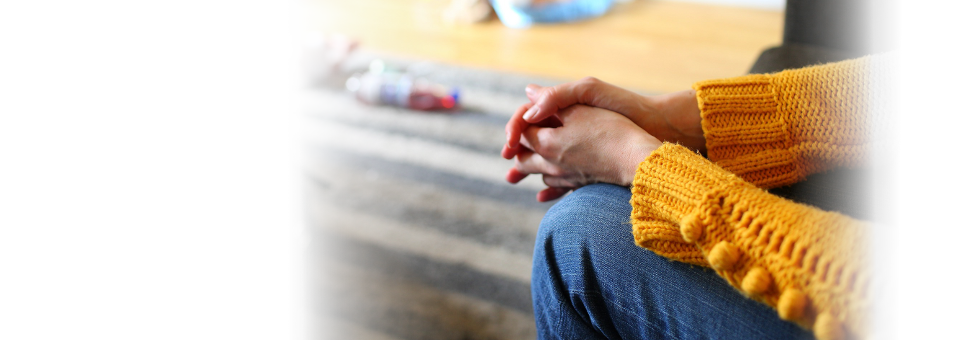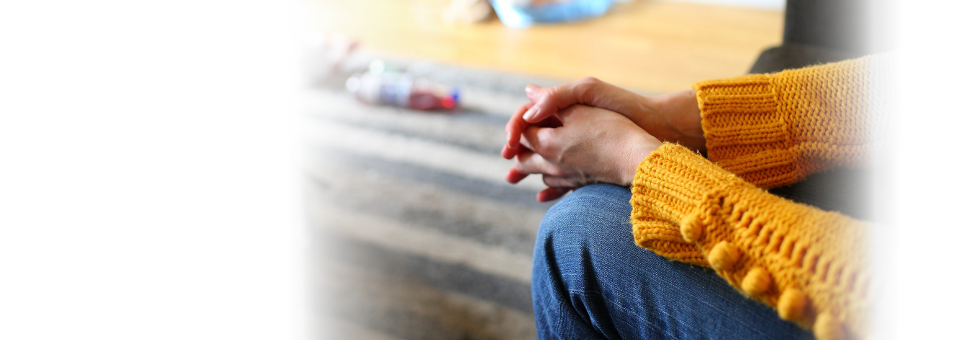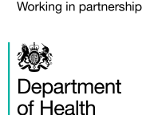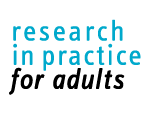Download the whole case study as a PDF file (515KB)
Maria is 24. She had a diving accident when she was 20, and now uses a wheelchair due to a physical disability. She has a 15-month old daughter, Sophia, with her long term partner, Graham. Sophia was recently subject to a referral to children’s services, who have contacted Adult Social Care to see whether they might be able to provide support to Maria. Graham is reported to not be happy about this.
This case study considers issues around survivors with physical disabilities; multiagency working, adult safeguarding and child protection; and support to EU migrants.
When you have looked at the materials for the case study and considered these topics, you can use the critical reflection tool and the action planning tool to consider your own practice.
Case details
Download the case details as a PDF file (211KB)
Maria, 24, lives with her 15 month old daughter, Sophia, and Sophia’s biological father, Graham (34). Maria came to live in London from Greece at the age of 18. Maria’s teenage years were difficult as her father was emotionally and physically abusive towards her and her mother. Maria took a business studies course and was involved in the University Diving club. She met Graham at the club and they have been together ever since.
When she was 20 equipment failure during one of the dives caused Maria to sustain a spinal cord injury. Maria was rehabilitated from hospital. With professional support she was able to regain much of her independence although she suffers from chronic pain as a result of the injury, and anxiety and depression related to this. She uses a wheelchair and was allocated an accessible ground floor flat owned by a local housing association. Maria was advised that giving birth could further disable her but she was determined to have her baby.
Graham moved into Maria’s flat when she told him that she was pregnant. Shortly after this she cancelled her contract with the domiciliary care agency. She said that Graham was able to do everything that she and the baby would need. Graham took time off work to be present at every ante-natal class. He works full time at a race track. He sometimes has to work late and he doesn’t always know until he gets there how long the shift will be.
There has been a referral to adult services from children’s services. Children’s services have been alerted to concerns raised by health staff about Sophia’s lack of development, low weight and being frozen in her emotional responses. Maria is reported to seem tired, wary and dishevelled and potentially in need of social care support to be an effective parent. The housing association had had complaints from neighbours about the family’s dogs’ waste covering the shared ‘play’ area and that they seemed dangerous. Graham is reported to be offended at the idea that they are not coping as he now manages the household as well as working.
Assessment
In this section are two downloadable PDFs – one is a partly completed assessment form related to this case study, and another is an example of what a completed form could look like.
Suggested exercise
Download the partly completed assessment as a PDF file (493KB)
Download the completed assessment as a PDF file (497KB)
Use the partly completed assessment form:
- What actions would you discuss with Maria to ensure her immediate and longer term safety?
- What precautions would you need to take to avoid putting her at higher risk of harm?
- What is your analysis of the situation? Is coercive control occurring? What is the evidence of this?
- What is your conclusion?
DASH- RIC
Download the blank DASH_RIC as a Word .doc file (226KB)
The purpose of the DASH risk checklist is to give a consistent and simple tool for practitioners who work with adult victims of domestic abuse in order to help them identify those who are at high risk of harm and whose cases should be referred to a MARAC meeting in order to manage their risk. If you are concerned about risk to a child or children, Safe Lives recommend that you should make a referral to ensure that a full assessment of their safety and welfare is made.
There are two downloads on this page.
One shows a blank DASH risk checklist, with quick start guidance from Safe Lives. The key point is to remember that your professional judgement is key in making a decision about risk; a tool can help, but the score it comes out with is not definitive.
This is especially relevant when working with people with care and support needs, for whom some of the questions may not be relevant.
Download the case study DASH-RIC as a PDF file (206KB)
The other shows an example of a completed DASH relating to this case study, for you to critique and appraise.
Suggested exercise:
- Read the case details and full assessment document for this case study.
- Using the information contained, fill out a blank DASH risk assessment tool.
- Discuss how you found it; did you have all the required information? Would you be able to get all the required information in practice? Would you make a referral to MARAC?
Topics
This section picks out three main topics from the case study featured. For Maria’s case study, the topics include:
- Working with survivors with physical disabilities
- Multi-agency working, adult safeguarding and child protection
- Support to EU migrants
A selection of references, tools and further reading for each topic is below.
Working with survivors with physical disabilities
Studies focussing on domestic violence and the experiences of women with physical disabilities draw from survivors’ narratives that illustrate increased vulnerability to coercion and control:
‘I mean, what normal wife would have all these professionals coming to the house and putting their hands all over her? All in the line of duty, but still—my body was for him alone . . .’ Bethany, a 36-year-old woman with multiple sclerosis, felt that her disability was an imposition on her husband; as a result, she felt obligated to sacrifice her home-based physical, speech, and occupational therapies … Bethany could not heal her disabled body; instead, she tried to limit its influence by surrendering her medical care. However, the abuse only escalated.’ (Rich, 2014:6).
Findings from research:
People with care and support needs are at higher risk of domestic abuse and other forms of abuse:
- Disabled women are twice as likely to experience violence as non-disabled women. (Hague et al, 2008)
- Half of disabled women may have experienced domestic violence. The report criticises the ‘serious lack of research in this country on the experiences of disabled women survivors of domestic violence’ (Hague et al, 2007)
Less service provision:
- Domestic abuse services – are few and far between, with scarce resources whilst awareness of disability is often inadequate
- Disability services – domestic abuse is often not seen as an issue with a lack of training & information about domestic violence amongst staff compounded by a similar lack of resources. (Hague et al, 2008)
In conclusion, people with care and support needs are more vulnerable to domestic (& other forms of) abuse AND less likely to have access to the services and the protection that may be needed.
Violence and abuse – what can I do? Information for disabled or Deaf women:
http://women-disabilities-violence.humanrights.at/sites/default/files/reports/gb_brochure_for_disabled_women_and_deaf_women.pdf
See tools, below:
- Tool 1: Safety Planning checklist for professionals
- Overarching tool on Making Safe Enquiries.
- Case study 4 Tool 2: Social Work Capabilities in Working with Disabled Women Survivors
Multi-agency working, adult safeguarding and child protection
Home Office Statutory Guidance highlights perpetrator behaviour which preys on the victim’s fear of losing their child and using such threats as a means of coercion and control:
‘A victim may be fearful of their children being taken away if they make a report and the perpetrator may have tried to convince them that this is the case‘ (point 23: Home Office Guidance) .
Because of their condition mothers with physical disabilities and/or learning disabilities may be particularly fearful of losing their child to the abusing partner or of losing their child into the care of the local authority. In such instances the perpetrator, as carer of both the adult and child/children, can use coercion to heighten this fear. Communication between Children’s and Adult services is crucial when situations of coercion and control involve elements of both child and adult safeguarding, requiring both adult and child assessments. Here is one example of a joint policy on working with adults and children experiencing domestic abuse:
Working_Together_To_Safeguard_Adults_and_Children_from_Domestic_Abuse.pdf
In seeking to establish robust and regular channels of communication between agencies, Professor Marianne Hester devised the Three Planet Model which highlights the need to align the Domestic Violence planet (where the perpetrator’s behaviour is considered a crime and therefore involves criminal justice professionals), the Child Protection planet (which resides in the public and family law arena involving statutory child protection professionals and NSPCC), and the Child Contact planet (the private law arena involving CAFCASS professionals who consider the child’s right to contact with both parent/perpetrator and parent/DV survivor):
http://www.bris.ac.uk/news/2009/6703.html
Adding a further planet to the constellation – the ‘Adult Social Care’ planet – highlights the need for additional communication channels between Children’s and Adult services and Adult services and Adult safeguarding professionals:
See tools, below:
- Tool 3: The Four Planet model
- Tool 4: Family Model for Assessment
- See also: Topics and tools from Case study 5 (Betty) relating to using MARACs.
Support to EU migrants
It is important to look at other structural issues that put people at risk alongside consideration of their care and support needs (see Intersectionality topic, case study 1). A number of reports signal a rise in hate crime towards EU migrants including attacks against their homes which, in their current situation, Maria and Sophia could find it difficult to escape from or to seek help:
Corcoran and Smith (2016) Hate Crime, England and Wales 2015/16
The increase in hate crime in England and Wales after the EU referendum vote was reported in figures published by the National Police Chiefs’ Council (Oct, 2016) showing a 49% rise in hate crime incidents to 1,863 in the last week in July 2016 when compared with the previous year. The week after saw a record 58% increase in recorded incidents whilst later data showed that the increase in hate crime continued, although the level of increase then dipped.
In September 2016 The Guardian reported:
‘Sir Bernard Hogan-Howe, the Metropolitan police commissioner, told a hearing at London’s City Hall in September 2016 that hate crime was showing signs of decreasing after the sharp rise in June and July, but it had still not returned to pre-referendum levels… He added: ‘The absolute numbers are low, but we think it is massively under-reported [crime]. Sadly, people don’t tell us about the harassment and the abuse that we know will go on out there.’
Sophie Linden, London’s deputy mayor for policing, who was hosting the hearing, said she was still getting daily reports about hate crime in the capital. ‘It is worrying that it does not appear to have gone back down to pre-referendum levels.’
A survey by the Guardian found that European embassies in Britain had logged dozens of incidents of suspected hate crime and abuse against their citizens since the referendum:
Tools
- Tool 1: Checklist – Developing safety plans with adults with care and support needs experiencing domestic abuse
Professionals advising adults with care and support needs (referred to here as ‘adults’) and managing safety plans should follow the checklist of actions.
- Tool 2: Social work capabilities in working with disabled women survivors
This tool is based on the recommendations drawn from disabled women’s suggestions for improvement in practice in Hague et al’s paper ‘Making the Links’ (2014: 26).
We have mapped the women’s seven suggestions to the domains of the Professional Capabilities Framework, and added our own suggestions on domains 6 and 9.
- Tool 3: The four planets model
Based on Marianne Hester’s Three Planets model; with the addition of a fourth ‘planet’, Adult Social Care.
Consider all the different agencies who might be involved in a case like Maria’s.
- Tool 4: Family model for assessment
You can use this tool to help you consider the whole family in an assessment or review.
Tool 1: Checklist - Developing safety plans with adults with care and support needs experiencing domestic abuse
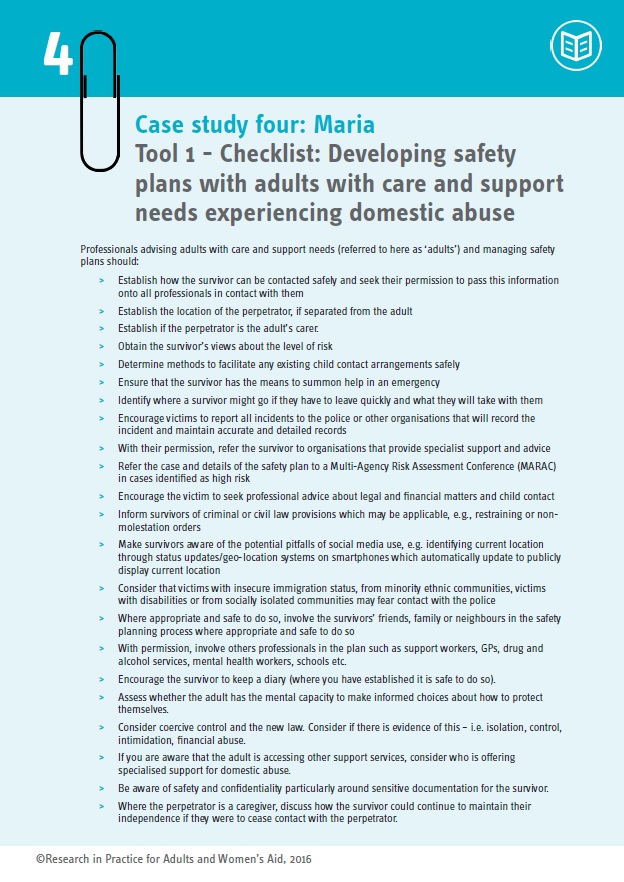
Download the tool as a PDF file
Professionals advising adults with care and support needs (referred to here as ‘adults’) and managing safety plans should:
- Establish how the survivor can be contacted safely and seek their permission to pass this information onto all professionals in contact with them
- Establish the location of the perpetrator, if separated from the adult
- Establish if the perpetrator is the adult’s carer.
- Obtain the survivor’s views about the level of risk
- Determine methods to facilitate any existing child contact arrangements safely
- Ensure that the survivor has the means to summon help in an emergency
- Identify where a survivor might go if they have to leave quickly and what they will take with them
- Encourage victims to report all incidents to the police or other organisations that will record the incident and maintain accurate and detailed records
- With their permission, refer the survivor to organisations that provide specialist support and advice
- Refer the case and details of the safety plan to a Multi-Agency Risk Assessment Conference (MARAC) in cases identified as high risk
- Encourage the victim to seek professional advice about legal and financial matters and child contact
- Inform survivors of criminal or civil law provisions which may be applicable, e.g., restraining or non-molestation orders
- Make survivors aware of the potential pitfalls of social media use, e.g. identifying current location through status updates/geo-location systems on smartphones which automatically update to publicly display current location
- Consider that victims with insecure immigration status, from minority ethnic communities, victims with disabilities or from socially isolated communities may fear contact with the police
- Where appropriate and safe to do so, involve the survivors’ friends, family or neighbours in the safety planning process where appropriate and safe to do so
- With permission, involve others professionals in the plan such as support workers, GPs, drug and alcohol services, mental health workers, schools etc.
- Encourage the survivor to keep a diary (where you have established it is safe to do so).
- Assess whether the adult has the mental capacity to make informed choices about how to protect themselves.
- Consider coercive control and the new law. Consider if there is evidence of this – i.e. isolation, control, intimidation, financial abuse.
- If you are aware that the adult is accessing other support services, consider who is offering specialised support for domestic abuse.
- Be aware of safety and confidentiality particularly around sensitive documentation for the survivor.
- Where the perpetrator is a caregiver, discuss how the survivor could continue to maintain their independence if they were to cease contact with the perpetrator.
[_/su_spoiler]
Tool 2: Social work capabilities in working with disabled women survivors

Download the tool as a PDF file (577KB)
This tool is based on the recommendations drawn from disabled women’s suggestions for improvement in practice in Hague et al’s paper ‘Making the Links’ (2014: 26).
We have mapped the women’s seven suggestions to the domains of the Professional Capabilities Framework, and added our own suggestions on domains 6 and 9.
Domain 1 Take advice from, and consult with, disabled women.
Domain 2 Take disabled women seriously and avoid being patronising.
Domain 3 Develop accessible services.
Domain 4 Do not threaten disabled women with institutionalisation if no refuge space is available. Develop good accessible alternative accommodation, both temporary and permanent, plus support to use it.
Domain 5 Be informed about disabled women’s needs.
Domain 6 Critically reflect on power relationships and intersectionality.
Domain 7 Provide accessible well-publicised domestic violence services (including refuge accommodation) that disabled women know about.
Domain 8 Develop disability equality schemes and reviews with input from disabled women.
Domain 9 Contribute to the learning of others who are working with disabled women survivors.
Hague, G et al (2008) Making The Links; disabled women and domestic violence. Bristol: Women’s Aid.
[_/su_spoiler]
Tool 3: The four planets model
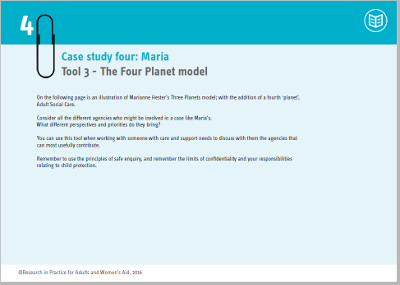
Download the tool as a PDF file (490KB)
Below is an illustration of Marianne Hester’s Three Planets model; with the addition of a fourth ‘planet’, Adult Social Care.
Consider all the different agencies who might be involved in a case like Maria’s.
What different perspectives and priorities do they bring?
You can use this tool when working with someone with care and support needs to discuss with them the agencies that can most usefully contribute.
Remember to use the principles of safe enquiry, and remember the limits of confidentiality and your responsibilities relating to child protection.
[_/su_spoiler]
Tool 4: Family model for assessment
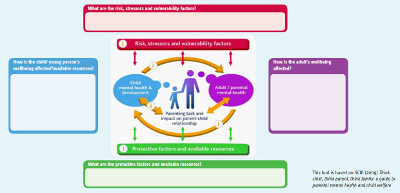
Download the family model for assessment as a PDF file (490KB)
You can use this tool to help you consider the whole family in an assessment or review.
[_/su_spoiler] [_/su_accordion]
References
Hague, Gill; Thiara Ravi K; Magowan Pauline; Mullender, Audrey (2008) Making the Links: Disabled women and domestic violence: Summary of findings and recommendations for good practice. Women’s Aid
Hague G Thiara R and Magowan P (2007) Disabled women and domestic violence: Making the links. An interim report for the Women’s Aid Federation of England. Women’s Aid
Rich, Karen (2014) My body came between us: accounts of partner-abuser women with physical disabilities. Journal of Women and Social Work, 1-16.
Woodin S, Shah S, Tsitsou L (2014) Access to specialised victim support services for women with disabilities who have experienced violence. University of Leeds. Available online: http://women-disabilities-violence.humanrights.at/sites/default/files/reports/empirical_report_uk.pdf
